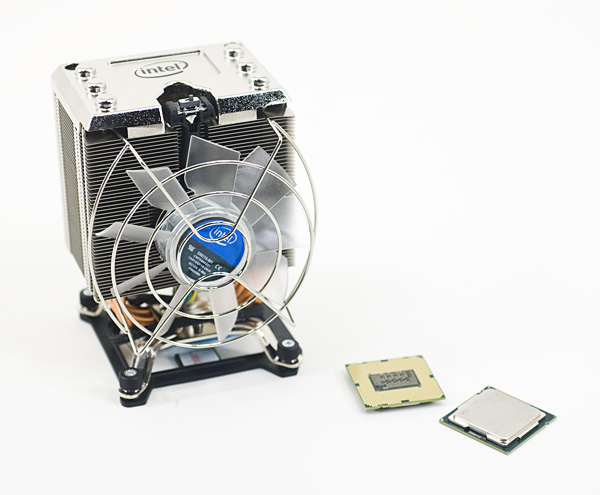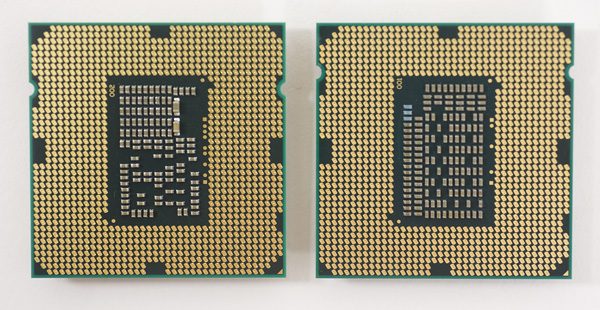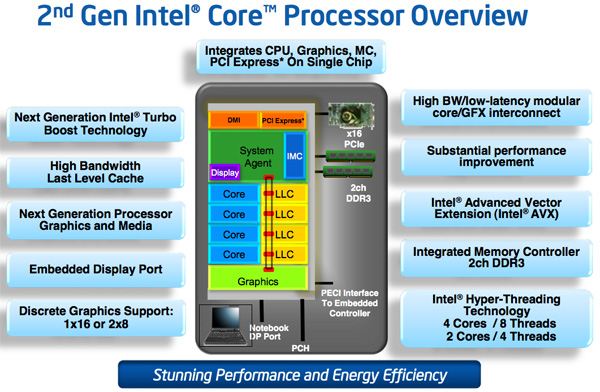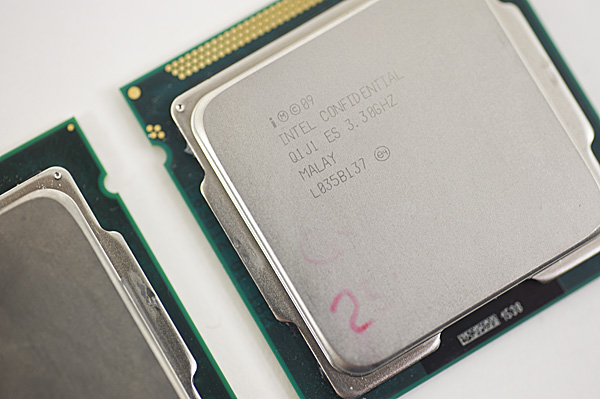The Sandy Bridge Review: Intel Core i7-2600K, i5-2500K and Core i3-2100 Tested
by Anand Lal Shimpi on January 3, 2011 12:01 AM ESTIntel never quite reached 4GHz with the Pentium 4. Despite being on a dedicated quest for gigahertz the company stopped short and the best we ever got was 3.8GHz. Within a year the clock (no pun intended) was reset and we were all running Core 2 Duos at under 3GHz. With each subsequent generation Intel inched those clock speeds higher, but preferred to gain performance through efficiency rather than frequency.
Today, Intel quietly finishes what it started nearly a decade ago. When running a single threaded application, the Core i7-2600K will power gate three of its four cores and turbo the fourth core as high as 3.8GHz. Even with two cores active, the 32nm chip can run them both up to 3.7GHz. The only thing keeping us from 4GHz is a lack of competition to be honest. Relying on single-click motherboard auto-overclocking alone, the 2600K is easily at 4.4GHz. For those of you who want more, 4.6-4.8GHz is within reason. All on air, without any exotic cooling.
Unlike Lynnfield, Sandy Bridge isn’t just about turbo (although Sandy Bridge’s turbo modes are quite awesome). Architecturally it’s the biggest change we’ve seen since Conroe, although looking at a high level block diagram you wouldn’t be able to tell. Architecture width hasn’t changed, but internally SNB features a complete redesign of the Out of Order execution engine, a more efficient front end (courtesy of the decoded µop cache) and a very high bandwidth ring bus. The L3 cache is also lower and the memory controller is much faster. I’ve gone through the architectural improvements in detail here. The end result is better performance all around. For the same money as you would’ve spent last year, you can expect anywhere from 10-50% more performance in existing applications and games from Sandy Bridge.
I mentioned Lynnfield because the performance mainstream quad-core segment hasn’t seen an update from Intel since its introduction in 2009. Sandy Bridge is here to fix that. The architecture will be available, at least initially, in both dual and quad-core flavors for mobile and desktop (our full look at mobile Sandy Bridge is here). By the end of the year we’ll have a six core version as well for the high-end desktop market, not to mention countless Xeon branded SKUs for servers.
The quad-core desktop Sandy Bridge die clocks in at 995 million transistors. We’ll have to wait for Ivy Bridge to break a billion in the mainstream. Encompassed within that transistor count are 114 million transistors dedicated to what Intel now calls Processor Graphics. Internally it’s referred to as the Gen 6.0 Processor Graphics Controller or GT for short. This is a DX10 graphics core that shares little in common with its predecessor. Like the SNB CPU architecture, the GT core architecture has been revamped and optimized to increase IPC. As we mentioned in our Sandy Bridge Preview article, Intel’s new integrated graphics is enough to make $40-$50 discrete GPUs redundant. For the first time since the i740, Intel is taking 3D graphics performance seriously.
| CPU Specification Comparison | ||||||||
| CPU | Manufacturing Process | Cores | Transistor Count | Die Size | ||||
| AMD Thuban 6C | 45nm | 6 | 904M | 346mm2 | ||||
| AMD Deneb 4C | 45nm | 4 | 758M | 258mm2 | ||||
| Intel Gulftown 6C | 32nm | 6 | 1.17B | 240mm2 | ||||
| Intel Nehalem/Bloomfield 4C | 45nm | 4 | 731M | 263mm2 | ||||
| Intel Sandy Bridge 4C | 32nm | 4 | 995M | 216mm2 | ||||
| Intel Lynnfield 4C | 45nm | 4 | 774M | 296mm2 | ||||
| Intel Clarkdale 2C | 32nm | 2 | 384M | 81mm2 | ||||
| Intel Sandy Bridge 2C (GT1) | 32nm | 2 | 504M | 131mm2 | ||||
| Intel Sandy Bridge 2C (GT2) | 32nm | 2 | 624M | 149mm2 | ||||
It’s not all about hardware either. Game testing and driver validation actually has real money behind it at Intel. We’ll see how this progresses over time, but graphics at Intel today very different than it has ever been.
Despite the heavy spending on an on-die GPU, the focus of Sandy Bridge is still improving CPU performance: each core requires 55 million transistors. A complete quad-core Sandy Bridge die measures 216mm2, only 2mm2 larger than the old Core 2 Quad 9000 series (but much, much faster).
As a concession to advancements in GPU computing rather than build SNB’s GPU into a general purpose compute monster Intel outfitted the chip with a small amount of fixed function hardware to enable hardware video transcoding. The marketing folks at Intel call this Quick Sync technology. And for the first time I’ll say that the marketing name doesn’t do the technology justice: Quick Sync puts all previous attempts at GPU accelerated video transcoding to shame. It’s that fast.
There’s also the overclocking controversy. Sandy Bridge is all about integration and thus the clock generator has been moved off of the motherboard and on to the chipset, where its frequency is almost completely locked. BCLK overclocking is dead. Thankfully for some of the chips we care about, Intel will offer fully unlocked versions for the enthusiast community. And these are likely the ones you’ll want to buy. Here’s a preview of what’s to come:
The lower end chips are fully locked. We had difficulty recommending most of the Clarkdale lineup and I wouldn’t be surprised if we have that same problem going forward at the very low-end of the SNB family. AMD will be free to compete for marketshare down there just as it is today.
With the CPU comes a new platform as well. In order to maintain its healthy profit margins Intel breaks backwards compatibility (and thus avoids validation) with existing LGA-1156 motherboards, Sandy Bridge requires a new LGA-1155 motherboard equipped with a 6-series chipset. You can re-use your old heatsinks however.

Clarkdale (left) vs. Sandy Bridge (right)
The new chipset brings 6Gbps SATA support (2 ports) but still no native USB 3.0. That’ll be a 2012 thing it seems.













283 Comments
View All Comments
mosu - Monday, January 3, 2011 - link
If I want to spend every year a big lot of money on something I'll sell on eBay at half price a few months later and if I'd like crappy quality images on my monitor, then I would buy Sandy Bridge... but sorry, I'm no no brainer for Intel.nitrousoxide - Monday, January 3, 2011 - link
It really impressed me as I do a lot of video transcoding and it's extremely slow on my triple-core Phenom II X3 720, even though I overclocked it to 4GHz. But there is one question: the acceleration needs EU in the GPU, and GPU is disabled in P67 chipset. Does it mean that if I paired my SNB with a P67 motherboard, I won't be able to use the transcoding accelerator?nitrousoxide - Monday, January 3, 2011 - link
Not talking about SNB-E this time, I know it will be the performance king again. But I wonder if Bulldozer can at least gain some performance advantage to SNB because it makes no sense that 8 cores running at stunning 4.0GHz won't overrun 4 cores below 3.5GHz, no matter what architectural differences there are between these two chips. SNB is only the new-generation mid-range parts, it will be out-performed by High-End Bulldozers. AMD will hold the low-end, just as it does now; as long as the Bulldozer regain some part that Phenoms lost in mainstream and performance market, things will be much better for it. Enthusiast market is not AMD's cup of tea, just as what it does in GPUs: let nVidia get the performance king and strike from lower performance niches.strikeback03 - Tuesday, January 4, 2011 - link
I don't think we'll know until AMD releases Bulldozer and Intel counters (if they do). Seems the SNB chips can run significantly faster than they do right now, so if necessary Intel could release new models (or a firmware update) that allows turbo modes up past 4GHz.smashr - Monday, January 3, 2011 - link
This review and others around the web refer to the CPUs as 'launching today', but I do not see them on NewEgg or other e-tailer sites.When can we expect these babies at retail?
JumpingJack - Monday, January 3, 2011 - link
They are already selling in Malaysia, but if you don't live in Malasia then your are SOL :) ... I see rumors around that the NDA was suppose to expire on the 5th with retail availability on the 9th... I was thinking about making the leap, but think I will hold off for more info on BD and Sk2011 SB.slickr - Monday, January 3, 2011 - link
Intel has essentially shoot itself in the foot this time. Between the letters restrictions, the new chipset and crazy chipset differentiations between a P and a H its crazy.Not to mention they lack USB 3.0, ability to have an overclock mobo with integrated graphics and the stupid turbo boost restrictions.
I'll go even more and say that the I3 core is pure crap and while its better than the old core I3 they are essentially leaving the biggest market the one up the $200 dollars wide open to AMD.
Those who purchase CPU's at $200 and higher have luck in the 2500 and 2600 variants, but for the majority of us who purchase cpu's bellow $200 its crap.
Essentially if you want gaming performance you buy I3 2100, but if you want overall better performance go for a phenom II.
Hopefully AMD comes up with some great CPU's bellow the $200 range that are going to be with 4 cores, unlimited turbo boost and not locked.
Arakageeta - Tuesday, January 4, 2011 - link
It seems that these benchmarks test the CPUs (cores) and GPU parts of SandyBridge separately. I'd like to know more about the effects of the CPU and GPU (usually data intensive) sharing the L3 cache.One advantage a system with a discrete GPU is that the GPU and CPUs can happily work simultaneously without largely affecting one another. This is no longer the case with SandyBridge.
A test I would like to see is a graphics intensive application running while another another application performs some multi-threaded ATLAS-tuned LAPACK computations. Do either the GPU or CPUs swamp the L3 cache? Are there any instances of starvation? What happens to the performance of each application? What happens to frame rates? What happens to execution times?
morpheusmc - Tuesday, January 4, 2011 - link
To me it seems that marketing is defining the processors now in Intel rather than engineering. This is always the case but I think now it is more evident than ever.Essentially if you want he features that the new architecture brings, you have to sell out for the higher end models.
My ideal processor would be a i5-2520M for the desktop: Reasonable clocks, good turbo speeds (could be higher for the desktop since the TDP is not that limited), HT, good graphics etc. The combination of 2 cores and HT provides a good balance between power consumption and perfromance for most users.
Its desktop equivalent price-wise is the 2500, wich has no HT and a much higher TDP because of the four cores. Alternatively, maybe the 2500S, 2400S or 2390T could be considered if they are too overpriced.
Intel has introduced too much differentiation in this generation, and in an Apple-like fashion, i.e. they force you to pay more for stuff you don't need, just for an extra feature (eg. VT support, good graphics etc) that practically costs nothing since the silicon is already there. Bottomline, if you want to have the full functionality of the silicon that you get, you have to pay for the higher end models.
Moreover, having features for specific functions (AES, transcoding etc) and good graphics makes more sense in lower-end models where CPU power is limited.
This is becoming like the software market, where you have to pay extra for licenses for specific functionalities.
I wouldn't be surprised if Intel starts selling "upgrade licenses" sometime in the future that will simply unlock features.
I strongly prefer AMD's approach where all the fatures are available to all models.
I am also a bit annoyed that there is very little discusison about this problem in the review. I agree that technologically Sandy Bridge is impressive, but the artificial limiting of functionality is anti-technological.
ac2 - Tuesday, January 4, 2011 - link
Agreed, but, apart from the K-series/ higher IGP/ motherboard mess up (which I think should be shortly cleared up), all the rest of it is just smart product marketing...It irritates readers of AnandTech, but for the most people who buy off-the-shelf it's all good, with integrators patching up any shortcomings in the core/ chipset.
The focus does seem to be mobile, low-power and video transcode, almost a recipe for macbook!!